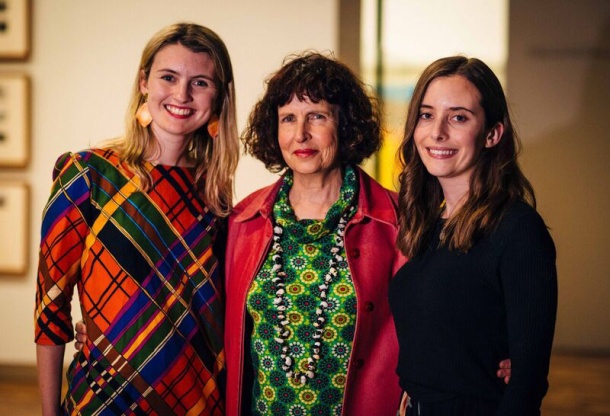
UQ Art Museum’s Isabella Baker and Emma McLean have curated a beautiful exhibition of selected etchings and paintings by prolific Brisbane artist, Judy Watson, who belongs to the Waanyi people of northwest Queensland. UQ Honours student and Art Museum Digital Media assistant Hilary Thurlow caught up with Isabella and Emma to find more about their creative curatorial approach to producing Judy Watson: concealed histories.
Q: How have you approached the task of curating Judy Watson: concealed histories? What are you trying to achieve with the exhibition?
A: We decided to approach this incredible opportunity to curate an exhibition of Judy Watson’s artworks by first looking through the UQ Art Collection to see what relationships we could draw out between the works held. We also wanted to bring attention to newly acquired works or artworks that hadn’t been displayed in some time. We then selected etchings and paintings that demonstrated Watson’s multifaceted practice, and her collaborative research-based approach to art-making.
We were also fortunate in visiting Judy at her studio, where we became more aware of her different techniques. We presented to Judy our ideas for the exhibition and what we envisioned for it. This was an extremely valuable part of the process, as we were able to listen to Judy talk about the selected artworks. In this way, we have approached the exhibition by focusing on research and collaboration – in our curatorial partnership together, in our relationship with the staff at UQ Art Museum, UQ Anthropology Museum, and importantly with Judy herself, as well as with her represented galleries (grahame galleries + editions and Milani Gallery). The artist and our Associate Director (Curatorial) Michele Helmrich, and more recently Curator Peta Rake, have all played a vital role in guiding our vision for the exhibition.
Overall, we wanted people to get a sense of Judy Watson’s diverse practice, as well as her commitment to research and collaboration. This is significant because Judy uses her art as a vehicle to give voice to histories otherwise underrepresented or silenced.
Q: What is the biggest challenge you have encountered throughout the process of curating Judy Watson: concealed histories?
A: One of our biggest challenges was how to best present information in the exhibition. Judy’s artworks are layered with meaning and visual cues – we could write about her practice for days! However, for the purpose of writing labels, we’ve tried to keep our information brief. Through this process, we have come to appreciate the delicate balance between presenting as much information about an artwork as possible, and capturing the interest of audiences in a succinct manner. A good way to think about it is, if you had to tell someone one thing about an artwork, what would it be? We’ve continued to ask ourselves this question.
Our other challenge has been working conceptually with the physical space. As emerging curators, we’re still developing our awareness of how different artworks will appear, depending on their dimensions and shape. In this way, we have been cautious not to overcrowd the space, and to let each artwork breathe.
Q: UQ Art Museum’s collection holds some of Judy Watson’s most important artworks. Do you have a favourite that features in the exhibition?
Emma: This is a difficult question to answer, because all of the artworks in this exhibition are so unique. However, I think my favourite would be the series heron island suite 2009/2010. Watson’s process of investigation in this work is fascinating, and the environmental message she conveys is powerful. Within these artworks you can see the shells, coral, feathers and other natural forms Judy collected while on Heron Island, during her residency at UQ’s Heron Island Research Station in 2009. The vibrant colours she employs echo the sparkling quality of this pristine, heritage-listed coral cay. She also sought permission to use graphs made by the leading scientists she met during her residency.These graphs, which monitor the impacts of climate change on the marine environment, signal to audiences that a deeper message of environmental degradation underlies the work.
Isabella: One of my favourites is the series experimental beds 2012, as it has so many different layers and meanings behind it. Judy Watson created the series as part of an artist residency at the University of Virginia, where she delved through their collection of Thomas Jefferson’s architectural drawings for the University of Virginia. She also investigated Jefferson’s mansion, Monticello, and research on his plantation. In doing this, she uncovered information about how, at Monticello, Jefferson exploited slaves to cultivate tobacco and mixed crops. This information is lesser known and contradicts the speeches Jefferson made promoting racial equality, including the role he played in drafting the 1776 American Declaration of Independence. The title experimental beds refers to Jefferson’s practice of experimenting with seeds and plants, introduced from Europe and Asia, to assess their suitability for Virginia’s climate. The series reveals how constructions of power enter many different aspects of life.
Q: What should visitors be most excited to see at the exhibition Judy Watson: concealed histories?
A: Visitors should look forward to a visually enjoyable exhibition that speaks to universal themes and political tensions. The beauty of Judy’s work draws viewers in before making them aware of more pervasive and layered messages. Her works exhibited here speak of environmental harms, racial tensions, and international events that shape history. She is both an Indigenous Australian artist of Waanyi ancestry, and an international artist, with an incredible perspective on human experiences within historical and environmental contexts.
Judy Watson: concealed histories is showing at UQ Art Museum from 18 August until 25 November 2018. Stay tuned for information about the exhibition and programs here.



